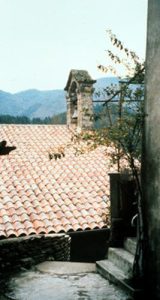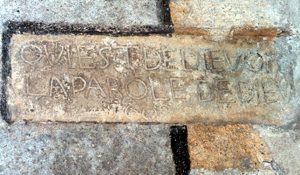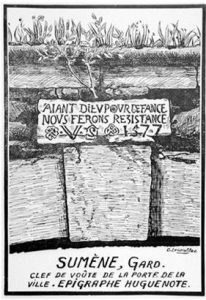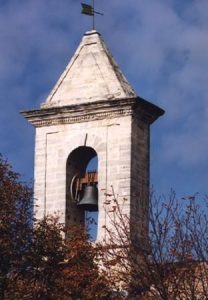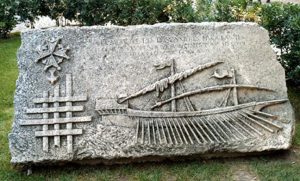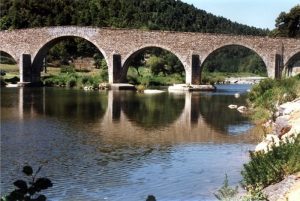Around the Mont Lozère
On 24 July 1702 at Pont-de-Montvert, on the Rieumalet stream, the abbot du Chayla, appointed to control the ‘newly converted’ Cévenols was murdered during the punitive raid organised by Abraham Mazel, Esprit Séguier and Salomon Couderc. The ‘Camisard war, the first peasants’ uprising in Europe, had started.
The Pont-de-Monvers incident aroused strong feeling in the region. De Broglie who headed the Royal troops in Montpellier, rushed to help his brother in law, Intendant Basville. The mutineers were hidden in the forests and set up revenge expeditions, killing priests and setting fire to churches as in Saint-André-de-Lancize.
In 1791 the temple in Vialas was given back to Reformed worship after having been turned into a Catholic Church upon the Revocation.
Catholics were massacred in Génolhac under the Camisard leader Joanny. But Julien called the Apostate, a former Protestant, turned Catholic, headed the Royal troops and took Genolhac back, and had the Protestants massacred. Joanny surrendered in 1704, then took up arms again and finally was killed at Pont-de-Montvert in 1711
Génolhac est le théâtre de massacres catholiques organisés par Joanny, chef camisard. Mais Julien dit l’Apostat, ancien protestant converti, à la tête de l’armée royale reprend Génolhac et fait massacrer les protestants. Joanny se soumet en 1704, puis reprend les armes et se fait tuer en 1711 à Pont-de-Montvert.
Around Bougès
Near Mijavols, the site called Trois Faux or Trois Faillards, is a reminder of the meeting of the 60 members of the punitive expedition against the abbott du Chayla, on 24 July, 1702.
In Cassagnas, Protestant children were baptised in the spring named Font Del Batéjadou during the Desert period.
The temple in Collet-de-Dèze escaped destruction thanks to it being turned into a hospital by the Marquise de Portes whose castle was used as a prison before and after 1685. The terrible Marquise wanted to convert her Protestant vassals at all costs, even forcefully.
Around Barre-des-Cévennes
Barre-des-Cévennes escaped the great fire in the Cévennes area in 1703 because it housed the Royal garrison.
Coming from Florac on the rue de Barre, a house still has the engraved stone taken from above the door of the temple (demolished in 1685) with the inscription ‘Qui es de Dieu oit la parole de Dieu’ – ‘Who is of God hears the word of God’ 1608.
The Plan de Fontmort
Bloody ambushes took place, notably in May 1704 under Rolland. Nearby the chemin de Basville, the Intendant of the Languedoc region, was used to convey armament and supplies. An obelisk set in 1887 reminds of the martyrs of that period.
At L’Hospitalet, in the night of 23 to 24 September 1689, predicants Brousson and Vivent assembled leaders to organise resistance actions with the help of the Refuge pastors. Basville’s repression after the covert uprising. Was fierce: 6 were sentenced to death and 8 to galleys for life.
At Saint-Germain-de-Calberte, the château belonging to the pastors father and son, of Cros de Montmars, was taken again by the Abbott du Chayla, the inspector of missions. Together with surrounding the houses it formed real ecclesiastical complex where seminarians, heads of schools and schoolchildren were trained until 1694. The body of the Abbott killed at the Pont-de-Montvert was put to rest in the church at Saint-Germain-de-Calberte.
Around the Aigoual
At Fraissinet-de-Fourques a fierce vendetta organised by the Camisards took place on 21 February, 1703.
At Sumène, on the gate of the city one can read the Huguenot inscription ‘Ayant Dieu pour Défense, nous ferons résistance’Having God for Defense, we will resist’.
At Salgas the castle of the baron of the same name, sentenced to the galleys by Intendant Basville can still be seen.
Valleraugue conserves the memory of François Vivent who negociated with Basville the departure of the Cévenols for Spain as early as 1686. He was killed near Anduze in 1692.
Lasalle was a stronghold of Protestant resistance. As early as 1686 the first Desert assemblies were held there. The Camisards found refuge in the Pagès caves.


